Review: 2015 Toyota Tundra TRD Pro
Does the Tundra TRD Pro fit the bill for its $40,000-plus price tag? We hit the road and the dirt to find out
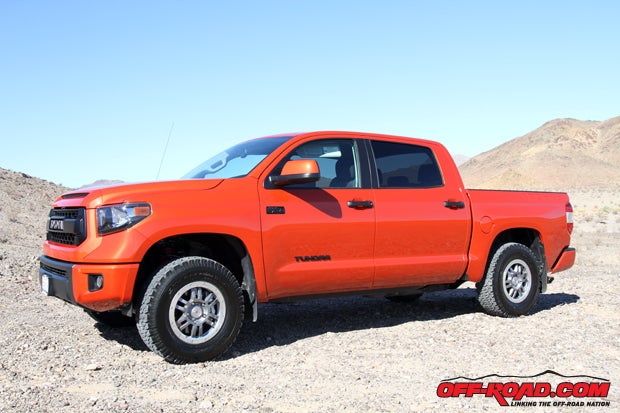
Whether it be a Dukes of Hazard-themed horn, an overly aggressive use of chrome accessories, different tires or upgraded suspension, car customization has been a part of the automotive world since day one. It always will be. If you have any shred of doubt, look no further than the 1.1-million square feet of space the 2014 SEMA Show filled at the Las Vegas Convention Center – nothing but customized vehicles and aftermarket products as far as the eye could see.
The idea of car customization for some might be plopping a bumper sticker on their car or putting on a seat cover, but that’s not the case for the off-roader. Nope, the off-roader always finds something to upgrade to tackle demanding, off-highway terrain. So instead of forcing the off-roader to head out to the parts shop right after they buy their vehicle, Toyota unveiled its new line of TRD Pro vehicles to take out all of that hassle. For 2015, Toyota is offering a TRD Pro, Tundra, Tacoma and 4Runner, all of which offer Toyota Racing Development off-road parts that come together to produce vehicles above and beyond anything Toyota has offered in a TRD package before. That means these are trail-ready vehicles still backed by the manufacturer, which is pretty cool if you ask us.
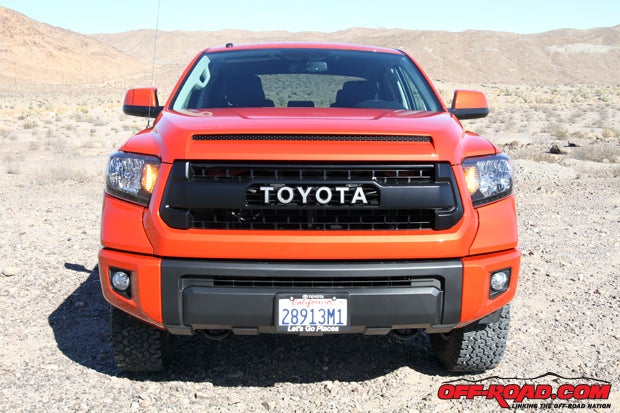
We’ve had a chance to get behind the wheel of the TRD Pros a few times in the past year, first checking them out when Toyota first unveiled them to the press. We were lucky enough to get an invite to drive the TRD Pros through the Mojave Preserve en route to Las Vegas for this year’s SEMA Show (see our Vegas: The Hard Way story). After the trip, we got our hands on a Tundra TRD Pro for a little more seat time. Although we had spent quite a bit of time in a pre-production version of the truck, we wanted to see how the production version felt and get some more real world numbers on the truck.
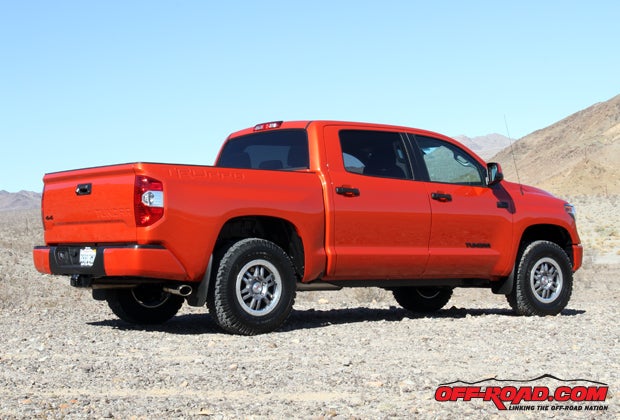
What Makes this TRD a Pro?
So what exactly makes a TRD Pro better than a regular Tundra with a TRD off-road package? As TRD Design Engineer Ted Moncure explained to us, the TRD Pro is designed to take the TRD package to the next level, with idea to make these vehicles the most capable that Toyota has ever produced. So the Tundra TRD Pro is built to be ready for the trail right out of the box – no additions necessary.
For the Tundra, the key upgrades start with the suspension, as 2.5-inch remote-reservoir Bilstein shocks with TRD-tuned Eibach springs are fitted up front to offer considerably improved off-road performance, as well as provide an additional 2 inches of lift for added clearance. The Bilstein monotube shocks feature a 60mm piston that is significantly larger than the 46mm pistons found in the OE shock. The new Bilsteins also offer three-stage position-sensitive valving to help soak up the ever-changing off-road terrain. Out back, TRD fits the rear suspension with the same 2.5-inch remote-reservoir Bilstieins to help compliment the TRD off-road leaf springs.
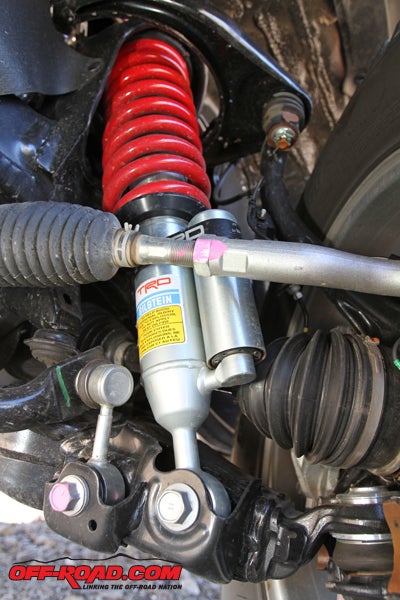 |
Although an 18-inch wheel is standard on the Tundra, the TRD Pro features a unique 18-inch black alloy TRD Pro wheel – and yes, this is ultimately just for looks. But Toyota does outfit the TRD Pro wheels with more aggressive Michelin LTX AT2 tires (P275/65/R18), roughly 32-inch tires. For our test truck, however, Toyota had outfitted the Tundra with even more aggressive BFGoodirch All-Terrain T/A KO tires for our Vegas: The Hard Way trip. For added protection, the Tundra TRD Pro features a 1/4-inch aluminum TRD front skid plate for underbelly protection (the OE fuel tank skid plate is retained also).
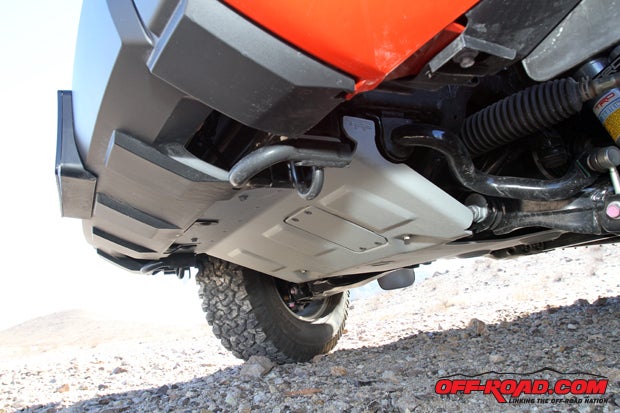
The Tundra TRD Pro is also outfitted with a TRD Performance Dual Exhaust System (we actually installed on another Tundra), which is designed to reduce backpressure and improve performance – all without exceeding the legal 95-decible noise limit. TRD representatives tell us the 304 stainless-steel exhaust system provides an additional 5 to 8 horsepower gain (noting that might be a conservative estimate). The spent exhaust gases travel through two independent, free-flowing, stainless-steel mufflers and exit behind each rear tire via polished dual tips etched with the TRD logo.
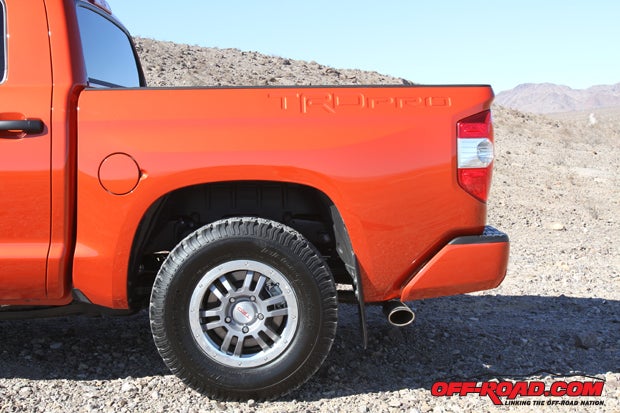
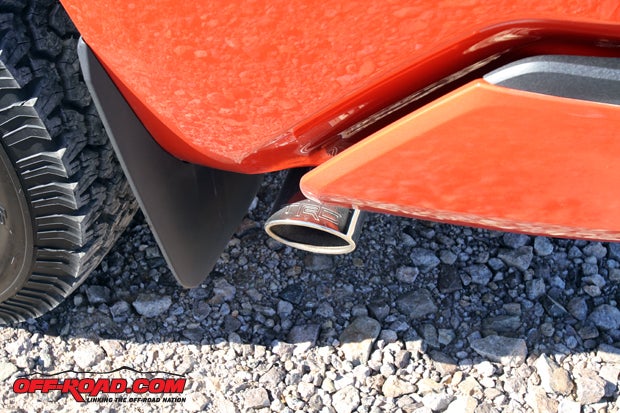
The Tundra TRD Pro is uniquely accented with standout features, such as its FJ Cruiser-inspired black grille with larger TOYOTA letter at its center. Large TRD Pro lettering is also stamped on the rear quarter panel of the truck bed, while black-tinted headlights are found up front and blacked-out badging accents the side of the Tundra. Inside the truck are custom TRD Pro seats that feature a red-and-black color scheme with a TRD logo stitched on just below the headrest. Red stitching is also found throughout the cabin of the truck for that added bit of customization.
How it Stacks Up
In the past year we’ve attended a handful of events related to the TRD Pro models, and of the three vehicles we’ve spent the most time behind the wheel of the Tundra. As the owner of an upgraded Tundra (suspension upgrades, 35s installed), it’s interesting to compare the different characteristics of a vehicle with handpicked parts versus one designed for a similar purpose from the manufacturer.
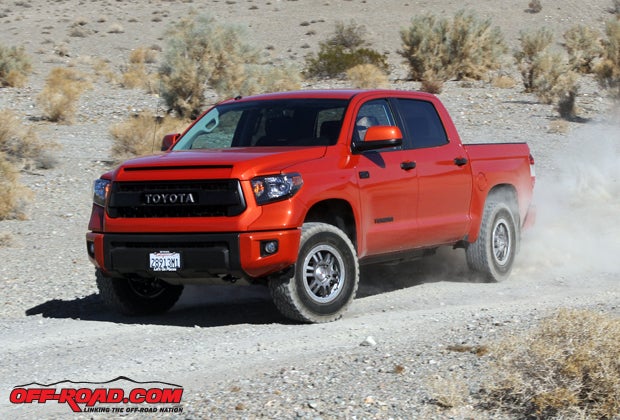
Until our recent Hard Way trip with Toyota to SEMA, we hadn’t gotten behind the wheel of a production truck, but now we had our hands on one. From pre-production to production, we honestly didn’t note any discernable difference between the trucks. What struck us the first time we drove the truck and stayed with us on this test is how well the Tundra TRD Pro drives on the highway. Yes, it is equipped with what amounts to a 2-inch leveling kit of up front, and its tires still don’t hit the 33-inch mark, but the TRD Pro maintains it factory ride quality in turns, overall straight-line stability and maneuverability in spite of its heightened stance and more aggressive suspension. That alone is a big plus for the truck, as the added off-road performance and additional lift aren’t a detriment to its on-road handling. Close-quarter navigating, such as sliding into parking spots in crowded parking areas or making adjustments in tight spots off the highway, isn’t sacrificed as well, which unfortunately I can’t say for my Tundra with 3 inches of front lift and 35-inch tires.
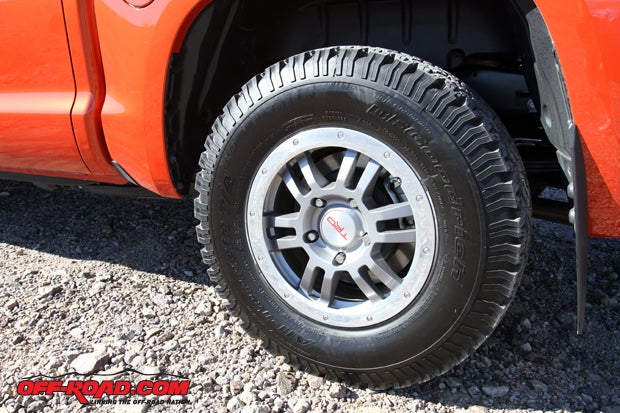
For fuel consumption, the truck was pretty much on par with Toyota’s rating of 13 mpg in the city, 17 on the highway. We averaged an overall highway fuel economy of 16.2 mpg, some of which was in headwind so we know the number could be better under more favorable conditions. Our city driving was a little lower than claimed at 12.1 mpg, but still it’s not too far off and about what we’d expect from the big V8 around town.
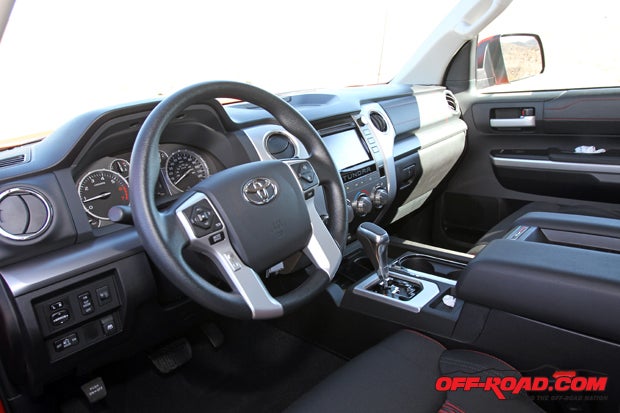
When it comes to getting into the dirt, we were impressed with the Tundra the first time we drove it and that hasn’t changed. The complaints we’ve heard from readers is that the tires aren’t big enough, or that the truck isn’t as aggressive as the Ford Raptor. Toyota says it didn’t look to build a “Raptor beater” in its Tundra TRD Pro, but instead the idea was to produce a functional off-road truck that pushes the envelope of TRD capability without sacrificing on-road performance. Sure, 33s wouldn’t hurt this truck one bit, but they also aren’t necessary for it to perform. As we noted, the production Tundra TRD Pro will come with Michelin LTX AT2s, but our test truck was outfitted with more aggressive BFGoodrich T/A KO all-terrains, which we do prefer if any serious off-roading is planned. Our gripe isn’t so much with the size of the tires, but the Michelins, while not bad tires for mostly road travel, aren’t quite as aggressive as we’d like.
The 2.5-inch remote-reservoir Bilstein shocks provide great performance off the highway, as the position-sensitive valving helps to soak up the uneven bumps of a severly weathered dirt road or whooped-out trails. As is the case with any off-road vehicle, finding the balance of driving the truck hard but not to the absolute limit ensure the truck will perform well and also last. The additional few inches of clearance up front provide enough travel to avoid bottoming out in most instances; really, you have to drive the truck pretty hard –arguably too hard – to make it bottom out. What’s most impressive is just how well the truck soaks up the bumps.
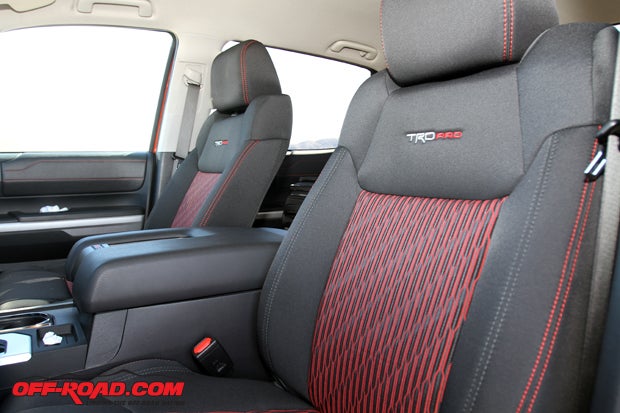
With an approach angle of 31 degrees and a departure angle of 21, the truck can handle most moderate trails without worry of scraping the color-matched bumpers. Certainly we wouldn’t take the Tundra TRD Pro on tight Jeep trails, but during our trip on the Mojave Preserve with Toyota and in our testing afterward, this truck can handle quite a bit – within reason. If you want to jump this truck you’re barking up the wrong tree, and there are plenty of YouTube videos to show you the folly of such an endeavor. But this truck doesn’t need to be babied in the dirt – as long as the driver keeps it within reason.
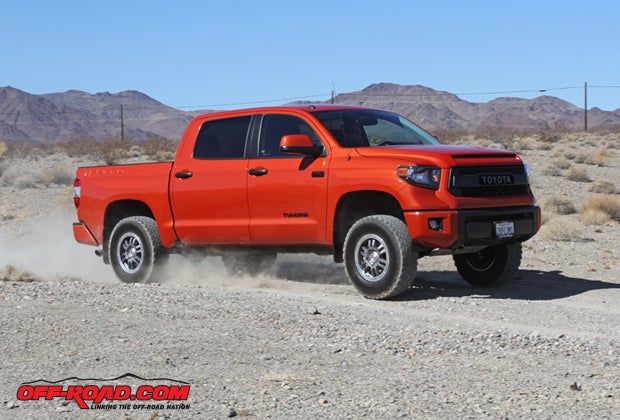
Off-Road Ready?
So, the key question for the Tundra TRD Pro, when all is said and done, is whether this truck is really off-road ready. Did Toyota produce a good enough vehicle that makes buying the TRD Pro worthwhile as opposed to buying a Tundra and outfitting the truck yourself? The answer is an emphatic yes! Including delivery, processing and handling, the Tundra TRD Pro Double Cab (with 6.5-foot bed) starts at $42,385, with the larger rear seat Crew Max version that we tested (with 5.5-foot bed) retails at $45,000. The price tag is within the range of a well-equipped Limited Tundra (a 2015 Double Cab 4X4 Limited 5.7L has a sticker price of about $40,600), and for our money, having the parts engineered from the TRD team, fully tested and already installed makes the truck even more alluring.
The Tundra TRD Pro is still a capable workhorse when needed, as it features a payload capacity of 1575 on the CrewMax (and 1630 on the Double Cab). The towing capacity on our CrewCab test truck is nearly 10,000 lbs., and is slightly more on the Double Cab version. For our money, unless you need the massive back seat, we’d opt for the larger bed and smaller back seat (which is still spacious enough for adults) of the Double Cab.
If we have to find a gripe, we would prefer that more aggressive tires come equipped on the Tundra (like our test truck). There are certainly others who will find other upgrades to add on as well, because when is enough ever enough? For our two cents, we feel the Tundra TRD Pro blends great road handling with a very usable off-road package that can get dirty during the daytime but cleans up nicely for dinner.
Specifications – 2015 Toyota Tundra TRD Pro CrewMax
Engine: 5.7-liter i-FORCE V8 DOHC
Horsepower: 381 @ 5,600 rpm
Torque: 401 lb.-ft. @ 3,600 rpm
Transmission: 6-speed automatic
Height: 77.2 in.
Track Width: 67.9 in. (front), 67.9 in. (rear)
Length: 228.9 in.
Wheelbase: 145.7 in.
Approach Angle: 31.0 degrees
Departure Angle: 21.0 degrees
Breakover Angle: N/A
Ground Clearance: 10.6 in.
Gross Vehicle Weight Rating: 7,200 lbs.
Towing Capacity: 9,800 lbs.
Payload Capacity: 1,575 lbs.
Fuel Tank: 26.4 gal.
Seating Capacity: 5
Gear Ratio: 4.30:1
MPG Rating: 13 city, 17 hwy
Aver. MPG (tested): 12.1 city, 16.2 hwy
Price: $45,000*
*Sticker price as tested, includes destination charges


 Your Privacy Choices
Your Privacy Choices